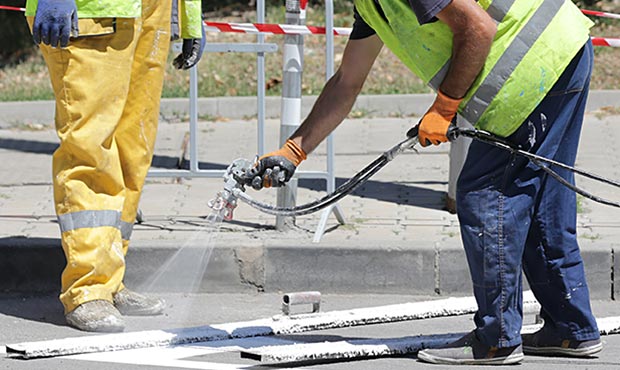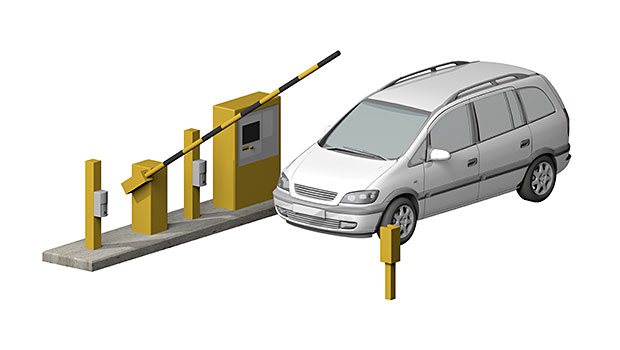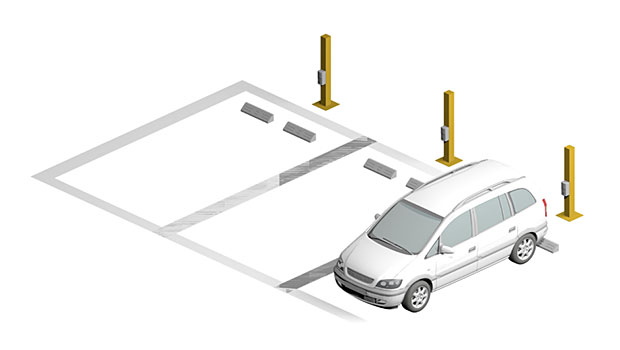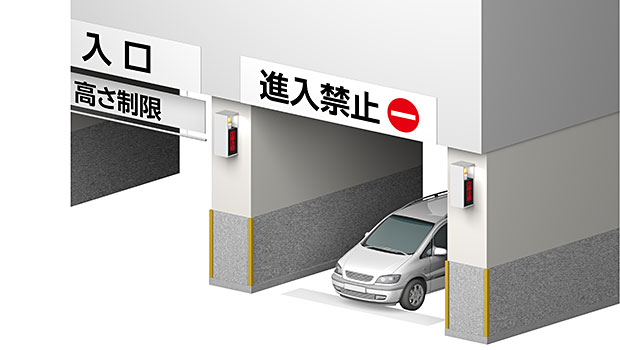Change the Look of Parking Areas Using Sensors That Don’t Need to Be Buried, and Which Halve the Construction Time

Parking lot management has attracted a great deal of attention as a method of utilizing idle land as an asset. The construction time and cost are important factors for both the parking lot operating company and the owner, because every additional day the parking lot can be open means additional income.
Until now, in order to detect a vehicle in a parking space, it was essential to embed loop coils inside the site. However, the construction tends to take longer as the ground is cut with a cutter, and there may be problems in the vicinity such as muddy water. New vehicle sensors to replace loop coils are coming to the fore as a key part in the operation of a new type of parking lot.
A loop coil sensor is a sensor that responds to metal objects and detects when a vehicle is present above the loop wire buried under the road surface. It is commonly used at paid parking lot gates, as well as in individual parking spaces. However, the following issues in construction and maintenance have reared their heads.
Problems
- In order to embed the loop coil, you need to cut the ground with a cutter
- The construction period for cutter construction can be long and drawn out
- Mud water flows around during construction
- Wires may break due to rainwater flooding and vehicle pressure
- When performing maintenance and removing the loop coil, extensive work such as digging the ground again is needed
- Detection of vehicles that use carbon-fiber-reinforced plastic, or CFRP, is very difficult
Furthermore, from the viewpoint of ensuring that the floor surface is waterproof and protecting the structure, there is a growing movement to prohibit loop coil burial in underground parking lots of commercial facilities and other buildings.
Next-Gen Vehicle Detection Sensors to Replace Loop Coils
This new type of sensor, combining microwaves (electromagnetic waves) and supersonic waves (sound waves) can detect vehicles without being embedded underground. Because they need only be set up on the poles in place at parking lots’ ticket machines, payment machines, boom gates, parking spaces, and so on, they cut the previous construction period of loop coil style (about six days) in half, taking only about three days. On top of that, the amount of work and cost involved in maintenance and land restoration is also decreased, with all sorts of advantages from a parking lot management perspective.

Vehicle Detection Sensor Technology
Optex researches issues in parking lot operations and locations, etc., and considers what kind of sensing is necessary. Our proprietary vehicle detection sensor detects the ingress, presence, and departure of vehicles using microwaves and ultrasonic waves. In addition, detection of vehicles and only vehicles (including CFRP) is made possible by a unique algorithm that does not notice people or animals. [Patent pending] Another feature is that it can be used in area prone to heavy snowfall.
The settings, such as the distance at which the sensor detects the vehicle, can be easily changed using the sensor’s built-in panel, and the sensor’s automatic correction function applies the settings while taking into account the characteristics of the location in which it is installed.
Lockless Coin Parking: A New Innovation in Paid Parking Lots
The parking lot business is evolving rapidly. Lockless (flapless) parking is gaining more and more traction as it becomes more mainstream. This is a type of parking lot without the locking plates that are the norm for conventional coin-paid parking lots. Lockless means no more steps, eliminating the risk of people getting lost or falling. Since it is not necessary to get over the locking plate at the time of parking, it is easy to park, and there is no concern of scraping the underbody with a low-bottom car. As a result, customers can use it with peace of mind, and so it is becoming a more and more popular concept.
Lockless parking lots control entry and exit by recording the vehicle number with a camera mounted on a pole. If an Optex sensor for detecting the presence or absence of a vehicle is installed on this pole, you can achieve an effective parking lot system without requiring a large installation. So our sensors work in perfect lockstep with the lockless parking system, with more and more parking lot managers taking advantage.
Examples of Installation/Application
By setting up a sensor at the gate of the parking lot it can activate the gate

Installing one at the rear of the vehicle storage area allows it to detect vehicle entry and exit

Set one at the vehicle entrance,
and watch it facilitate road traffic with an automated signal for a car leaving the parking lot

Frequently Asked Questions about Vehicle Detection Sensors
- Does the body color of the vehicle affect the detection?
-
On the principle of operation, the car body color has no influence.
- Are there any natural environment factors such as rain or snow that have an effect?
-
The automatic environmental change correction function allows it to be used safely outdoors.
In addition, it has a built-in heater to reduce snow coverage. - Isn’t there any maintenance required?
-
If the main unit is extremely dirty, there may be continuous detection even after the vehicle has left. In that case, lightly wipe it with a soft brush or cloth.
